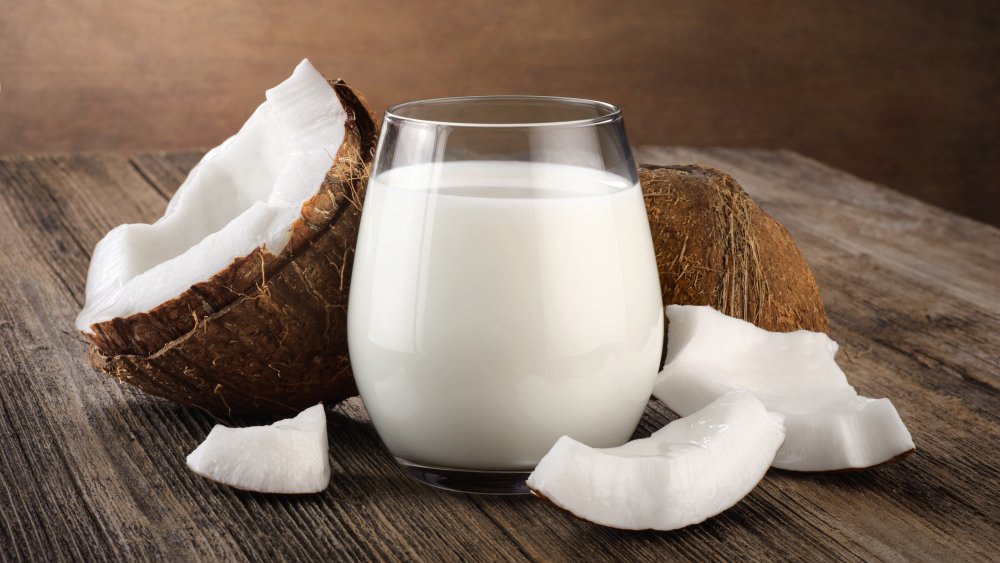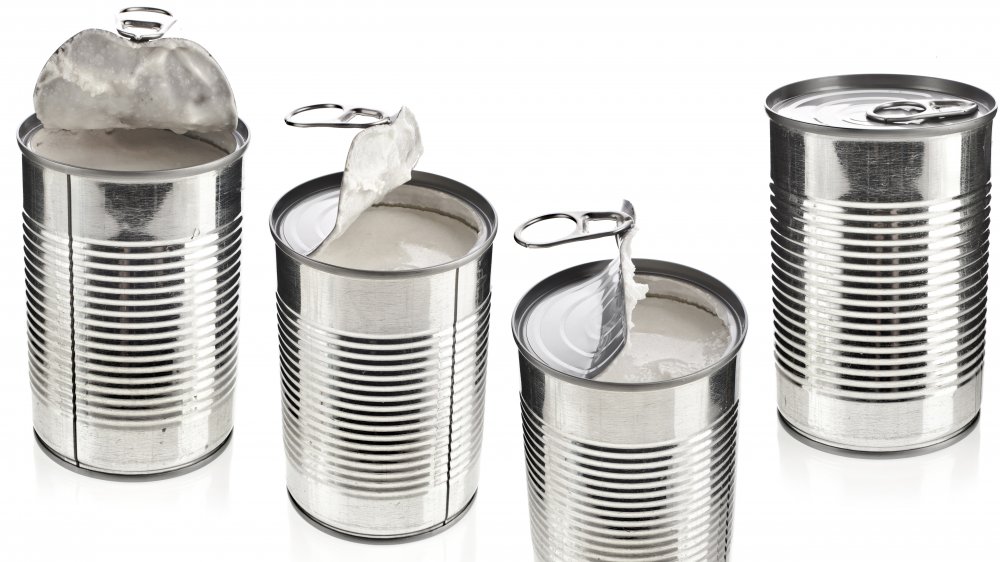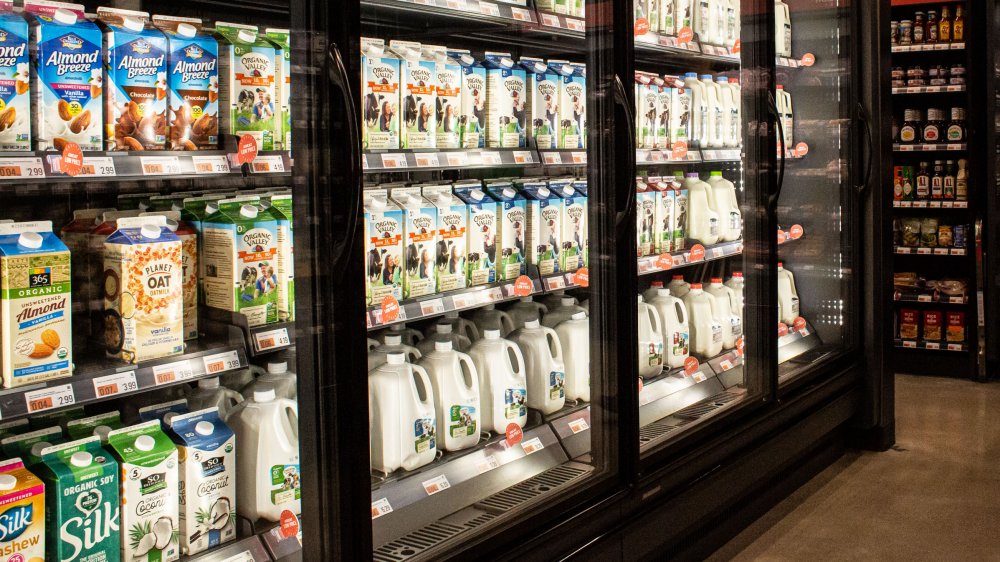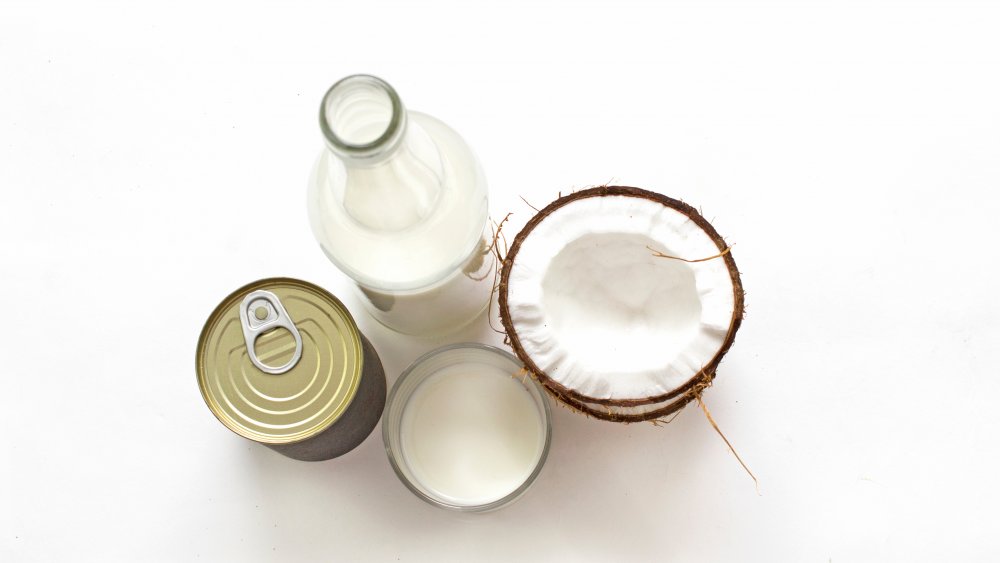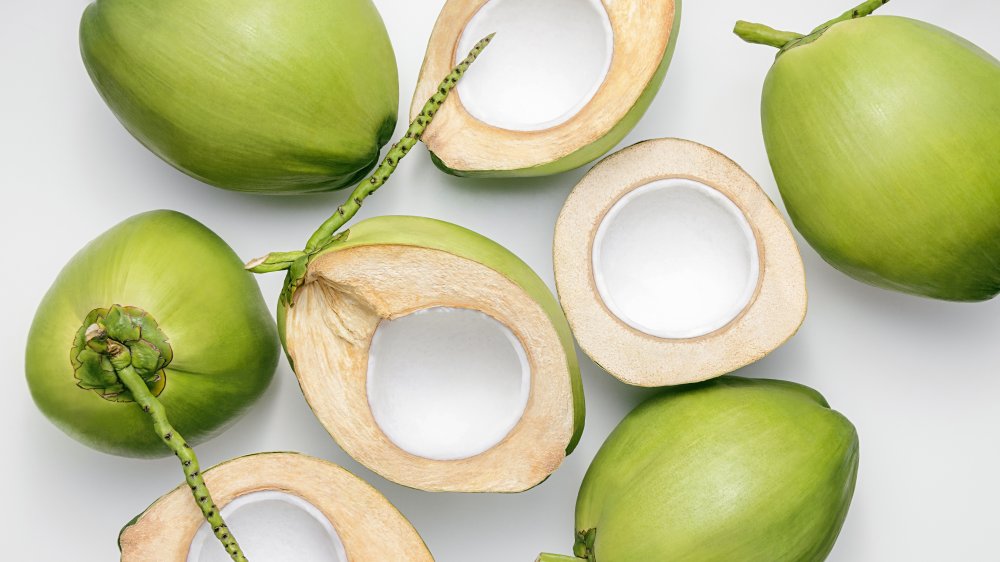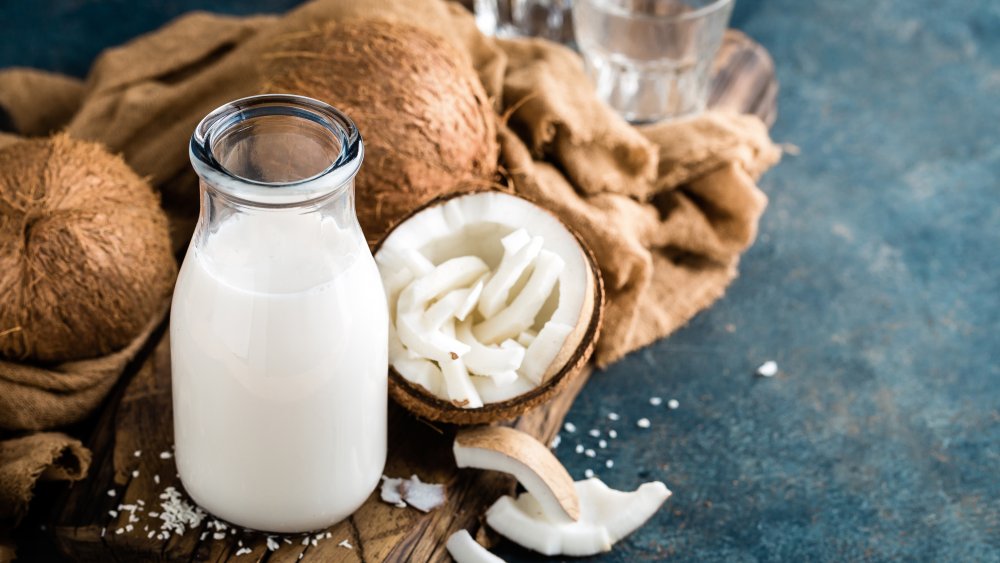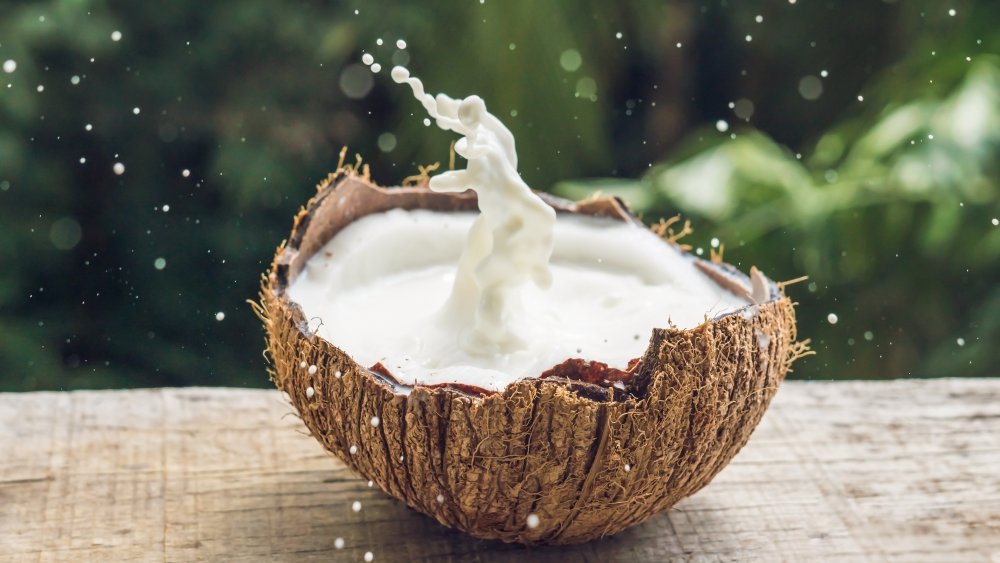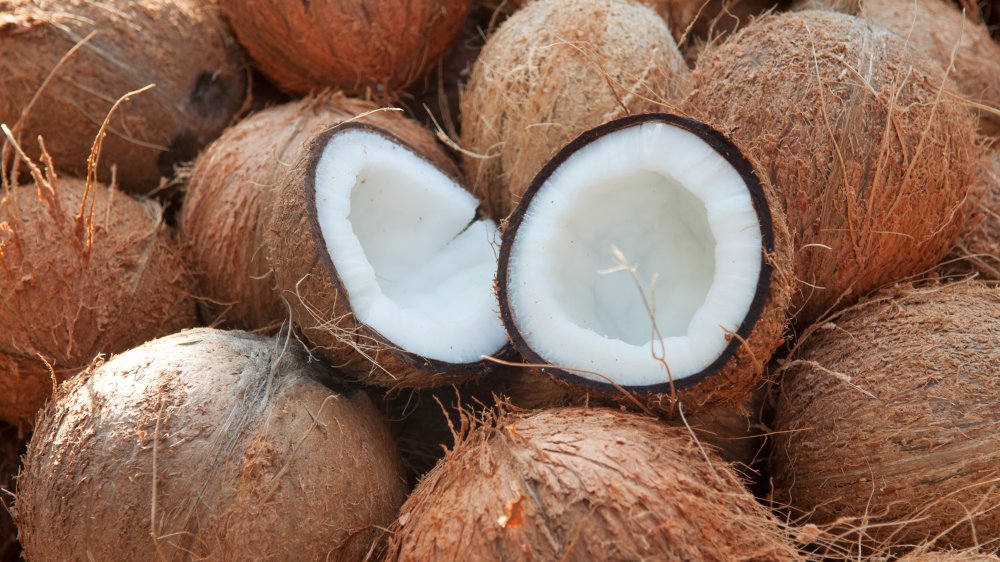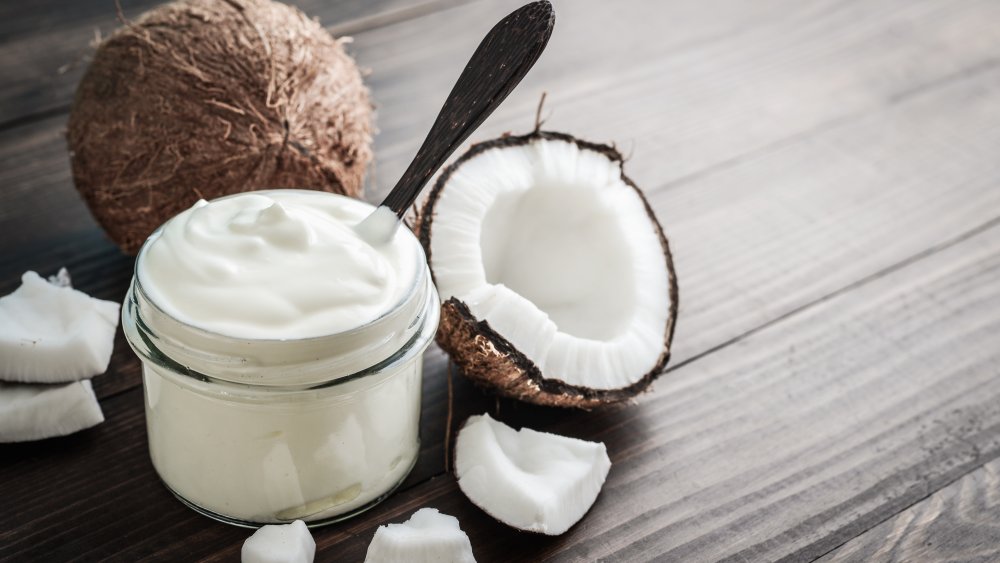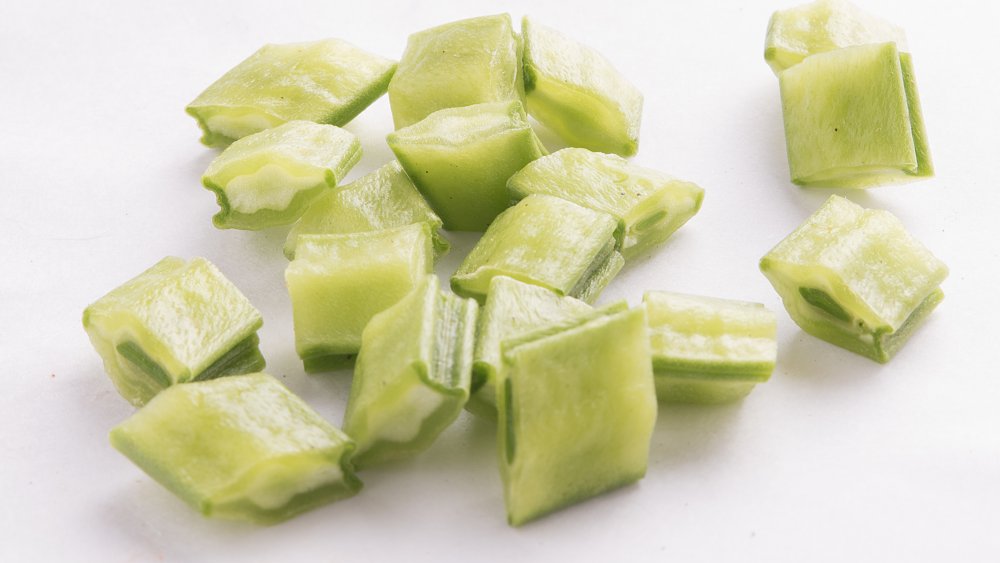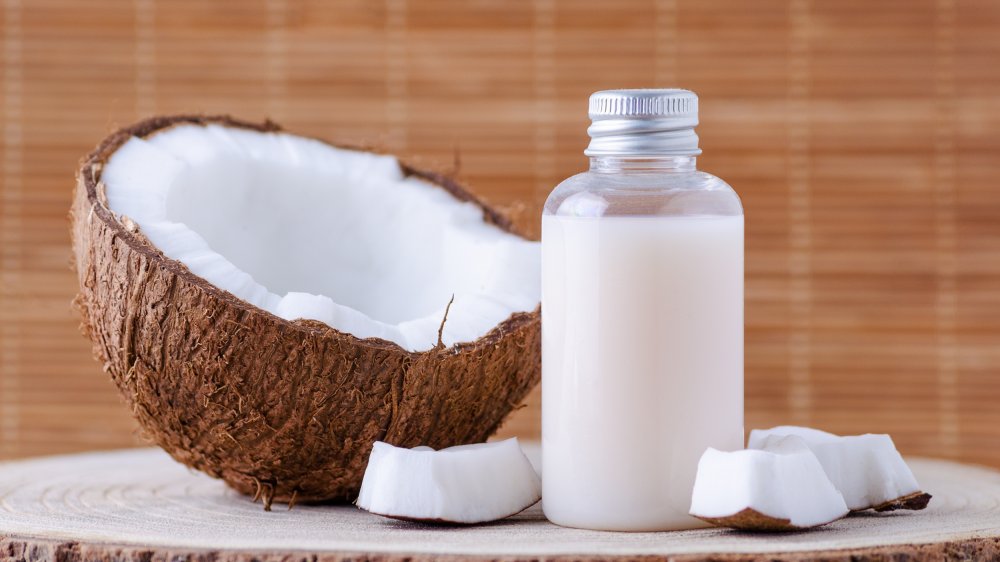The Untold Truth Of Coconut Milk
At this point, it may seem that milk can be made from almost anything. Cow's milk? Check. Goat milk? Absolutely. Oh, and don't forget all of those non-dairy milk alternatives from oat milk and almond milk to even hemp milk. And while the concept of using other substances to create alternative milk options is still relatively new, coconut milk has been a staple in Southeast Asian cuisine for much longer.
Made from, you guessed it, the meat found inside a coconut, coconut milk can be a rich addition to soups, curries, and smoothies, but it can also be enjoyed on its own as a milk substitute or poured in coffee or cereal. It's an incredibly versatile beverage, it can be adapted for use in almost any recipe, and for those who love the flavor of coconut, it's absolutely delicious. But what else is there to this milky white liquid? What else is under that tough, outer coconut shell? We decided to take a look. This is the untold truth of coconut milk.
There's multiple forms of coconut milk
When you think of coconut milk, what comes to mind may all depend on the type of cuisine you enjoy. Coconut milk actually comes in multiple forms, and it's important to understand the different options available.
When it comes to cooking, canned coconut milk is typically king. For many, it's a pantry staple, as it's shelf-stable and can be added to so many recipes. Canned coconut milk is a bit thicker than its boxed counterpart, imparting hints of coconut flavor and creaminess to a dish. For canned coconut milk, you may open the can to find that it has separated, with thick cream on the top, paired with a milky liquid, but adding it straight to a saucepan while cooking will bring the separation back together into its creamy form.
Boxed coconut milk, on the other hand, which is often found on the shelves in a carton, is typically used for quicker recipes. It's not as thick or creamy, but it makes a great milk alternative for cereal or smoothies, or even coffee if you just need a light addition. Its flavor isn't as strong as canned coconut milk, since it doesn't normally present the thick cream you see in a can, and often, it may have higher water content or other additives. A powdered form of coconut milk is also available and can be mixed with water, but it's not as prevalent at the grocery store as these other two options.
Coconut milk is rapidly growing in popularity
If you've visited the alternative milk section in the grocery store, you've likely noticed that the number of options is always increasing. And that's all due to demand. Coconut milk has been right alongside skyrocketing sales of other nut and plant-based kinds of milk. In 2018, the sales of refrigerated plant-based milks jumped by seven percent to $1.61 billion, making it very apparent that people had been craving other options to the normal cow's milk.
As the popularity of milk alternatives rises, whether choices are being made due to lactose intolerance, how versatile it is, or other dietary changes, coconut milk continues to soar. In 2017, global sales of coconut milk topped $830 million. And while it makes sense for sales to be high in Southeast Asian countries, as coconut milk is used in regional cuisine so frequently, sales in North America actually accounted for one-fourth of that number.
And it doesn't look like that popularity is quitting any time soon. Sales for coconut milk are still projected for an annual growth rate of 7.3 percent from 2017 to 2027.
Production of canned coconut milk takes quite a few steps
Although the concept of coconut milk seems fairly simple, just combining the coconut meat and water, the manufacturing process is a bit more complicated than that.
The process all starts by extracting the coconut meat, or coconut kernel. From there, the milky fluid found in the coconut kernel is mechanically extracted from the matured coconut. Often water is added, but it can stand on its own as well.
According to Science Direct, the process of actually making the coconut milk shelf-stable is where the real work comes in. Coconut milk has to be thermally processed before it can be packaged and make its way to a store near you. Once the coconut milk is extracted, it's heated to 92 to 95 degrees Celsius, with stabilizers added during the homogenization process. Once homogenized, the coconut milk can be added to a can while it's still hot, or it can go through an exhauster to cool it down before entering the can.
Coconut milk is not the same as coconut water
Coconut water has definitely seen a huge rise in popularity. As of 2004, coconut water saw barely any sales at all, and people pretty much thought it was useless, but that certainly has changed as the coconut water market was worth $2.2 billion and counting in 2017. And while coconut milk and coconut water seem very similar, of course, each being derived from the coconut, they certainly are not the same.
The main difference is how they're made. Coconut milk utilizes the white meat found inside a mature coconut. Coconut water, on the other hand, is the liquid found inside a green coconut, or a young coconut that's harvested for consumption. Young coconuts are typically used for coconut water after around six months, while a fully ripened or matured coconut isn't ready until 10 to 12 months.
Coconut water is actually the first stage before the coconut forms its solid white flesh as its maturing. Part of the water remains in liquid form, while the other part continues to ripen into coconut meat.
Coconut milk is packed with iron
Without iron, our bodies wouldn't be able to function all that well. Iron plays a huge role in the transportation of oxygen in the body, and it's generally pretty obvious when we're low on it as it can cause headaches, dizziness, and even body aches.
But luckily, if you're a coconut milk aficionado, you may be getting a huge dose of iron every time you drink it. One cup of raw canned coconut milk contains 7.46 milligrams of iron. And while that may not seem like a ton, it sure is in comparison to our daily recommended amounts.
According to Healthline, women ages 19 to 50 should be consuming at least 18 milligrams of iron per day. Men, on the other hand, ages 19 to 99 only need eight milligrams per day. Women certainly need more, but either way, coconut milk is definitely making a dent in that count, and using just one cup of it to cook with gives more than one-third of your daily recommended amount.
Coconut milk is great for your immune system
There are so many different reasons someone might enjoy coconut milk, whether it's because you're going dairy-free, or you simply want to make a Southeast Asian inspired dish. But you might as well add the great benefits for your immune system onto your list of benefits as well.
Because coconuts contain something called lauric acid, a long-chain fatty acid, inevitably passing those fatty acids into coconut milk, it may be one of the most beneficial things you can consume.
One study found that by pairing lauric acid and bacterial strains in a petri dish for experiments, many of the bacteria introduced didn't stand a chance. According to Medical News Today, the lauric acid managed to inhibit the growth of bacteria known to cause pneumonia, tuberculosis, and other ailments pertaining to respiratory illness. Meanwhile, it's also been found that lauric acid contributed to the death of cells in breast and endometrial cancer as well, providing an even greater benefit to add to the list.
People with tree nut allergies may be allergic to coconut milk
First of all, despite the deception in the name, coconuts are not actually nuts. Coconuts are actually a fruit, but because coconuts have an inner flesh, paired with a hard shell around it, coconuts are considered drupes, along with other fruits such as peaches and pears.
But, just because coconuts aren't truly classified as a nut doesn't mean those with tree nut allergies don't need to be careful.
Per Very Well Health, the Food and Drug Administration classifies coconut as a tree nut for labeling purposes, while in Europe they're not classified that way. Coconuts have the potential to have similar effects on those with tree nut allergies, such as itching, swelling of the throat, or wheezing, and for some, it could even be fatal. It all depends on the person consuming the coconut, their allergens, and the way that some of the proteins in the coconut can interact with the person to cause symptoms. And while it's uncommon, it's better to be safe than sorry before consuming coconut milk.
Coconut milk is high in fat, but that may be a good thing
When it comes to consuming food and beverages, typically we don't love to hear if something has a super high-fat content. The amount of fat a food item contains can definitely get a bad rap. But as it turns out, it's not quite the same for coconut milk.
Unsweetened coconut milk from a carton typically contains four grams of fat, with 3.5 grams of saturated fat per cup. Meanwhile, canned coconut milk really packs in the fat with 12 grams per cup and 10 grams of saturated fat. But don't just go throw out the coconut milk in your pantry after reading those numbers.
While it is true that most of the fat found in coconut milk is saturated fat, which we've all been trained to think of as bad for our bodies, coconut milk has a different kind. The fat found in coconut milk is called MCTs, medium-chain triglycerides, which means that they can be metabolized by the body quickly and converted to energy. The jury is still out on the research, as promoting the over-consumption of saturated fats would be frowned upon, but it is true that you may be consuming a different, better type of saturated fat with coconut milk that is more easily digested.
Coconut milk might help with inflammation
As if the benefits of consuming coconut milk couldn't get any better, there's another positive to throw in the mix. Coconut milk is a great addition to an anti-inflammatory diet.
When the body experiences inflammation, it's in response to things that might be causing it harm. When toxins enter the body, or injuries occur, our bodies naturally want to heal, so antibodies are released and blood flow is increased to fuel that process. Along the way, the body may mistake things that are causing it harm, and it tries to fight against it, causing continuous inflammation.
Inflammation can be presented in so many ways, including pain in a specific area, swelling, increased blood flow and heat, and more. But, adding coconut milk to your diet on a regular basis might just contribute to fighting that response. Studies have found that the extract and oils found in coconut milk helped to reduce swelling in injured rats and mice, and it may just have the potential to do the same for humans.
Many coconut milk varieties contain guar gum
If you've looked at your can or carton of coconut milk and found guar gum on the label, don't worry, there's no reason for alarm. While the name guar gum may sound like an odd additive, it's actually very common in many other foods.
Guar gum is an additive made out of legumes, or guar beans. It is often found in many foods such as ice cream, sauces, pudding, soup, and even cheeses, so your coconut milk certainly isn't alone. Typically, it's the only ingredient listed in canned coconut milk, in addition to the raw coconut and water.
Guar gum is used as an additive in foods in order to help thicken them. As it easily absorbs water, it's able to bind ingredients together. And as an added bonus, it adds soluble fiber to the mix, opening up the possibility that it may even help with digestive problems along the way.
Coconut milk can be incorporated into a huge variety of recipes
Coconut milk is one of the most versatile ingredients to incorporate into a multitude of recipes. Even if you're not a huge fan of the flavor of coconut, it's still a great addition to recipes to change the texture, and it absorbs the flavor of other recipe additions very well.
One of the most popular uses for coconut milk is for cooking soups or curries. It's a great base for a dish, with the ability to customize it with spices such as curry, garam masala, and turmeric. Adding vegetables such as onions, peppers, and basil is a popular choice as well.
But coconut milk can be so much more than just a dinner ingredient. Adding it to cocktails such as piña coladas or coconut martinis and fruit smoothies can make a huge difference in texture and flavor, or it can even be used to make whipped cream or non-dairy ice cream. It's wildly versatile, giving you the ability to make virtually any dish dairy-free, and for the most part, it allows for an even cup-by-cup substitution in a recipe.
You can still use coconut milk to froth for a latte
Long gone are the days of only using cow's milk for a latte. Of course, the popularity of using whole milk for a latte still lives on, as that's what consumers have been used to for years. But, if you thought you'd never have a frothy, creamy latte again after finding out you were lactose intolerant or choosing to make the switch to a non-dairy milk option, think again.
While options such as almond milk and soy milk can easily be added to a latte, coconut milk may be a better option for those looking for those stiff peaks of creamy froth, as coconut milk has a higher fat content than other milk alternatives. One cup of almond milk contains three grams of fat, while soy milk has four grams, versus the five grams of fat typically found in a cup of coconut milk.
The goal here is to mimic what traditional cow's milk does as it's being steamed. According to Cook's Illustrated, cow's milk froths well because the proteins and water found in it work together to form air bubbles, ultimately creating foam. As you froth milk, you need fat to keep the foam and bubbles stabilized, and that's where coconut milk comes in. With its high-fat content, it's able to hold its shape better and for longer, making it a great choice for a dairy-free latte.
You can make your own coconut milk at home
Let's face it. Coconut milk can get a bit expensive. Especially if you're adding it to your coffee every morning and on top of cereal, going through a carton of coconut milk can happen pretty quickly. And while buying it in a carton is as convenient as can be, there are options to make coconut milk on your own at home.
One economical option is to purchase cans of full-fat coconut milk and add water to them. Because a carton of coconut milk is basically the combination of creamy coconut milk and water, purchasing a can and mixing in additional water can produce a similar option to what's found in cartons.
Another option is to go the full DIY route and utilize a package of already-shredded coconut to do the job. Combine shredded coconut and water into a blender, let it sit for a bit, and then puree the mixture. Once blended, using a nut milk bag or cheesecloth to strain out the leftover coconut pulp will do the trick, leaving you with nice creamy milk to be used in any recipe.
